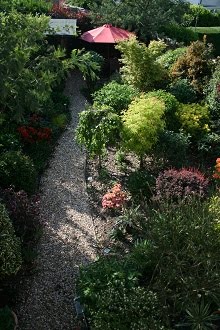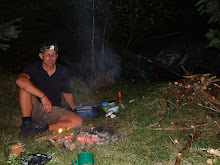 It is now that time of year when hedge cutting is at a peak. There isn't a day that goes by without this task having to be performed. Out of all the jobs in the garden, I have to say that trimming a nice hedge is my favourite. Whilst at Compton Acres in my earlier days, the two main types of shrub used were Taxus baccata, shaped into the precise battlements, domes and towers that we know and love, and Rhododendron ponticum for the massive banks that divided the different gardens from one another. Nowadays, as well as these varieties of plants, there are Laurels, Privet, Hawthorn, Buxus, Eleagnus and Lonicera, along with some major conifer hedging to attend to at the various places of work. Although hand shears are called upon to tidy the very bottom of hedges because of the usual collection of stones etc, nowadays I am able to call on my best friends the Stihl HS45 and HL95 petrol trimmers, the latter being a really mean piece of kit in the form of an extended trimmer with adjustable head angle. I know this may not work for the rest of you but this baby feels sooooo good when being used!
It is now that time of year when hedge cutting is at a peak. There isn't a day that goes by without this task having to be performed. Out of all the jobs in the garden, I have to say that trimming a nice hedge is my favourite. Whilst at Compton Acres in my earlier days, the two main types of shrub used were Taxus baccata, shaped into the precise battlements, domes and towers that we know and love, and Rhododendron ponticum for the massive banks that divided the different gardens from one another. Nowadays, as well as these varieties of plants, there are Laurels, Privet, Hawthorn, Buxus, Eleagnus and Lonicera, along with some major conifer hedging to attend to at the various places of work. Although hand shears are called upon to tidy the very bottom of hedges because of the usual collection of stones etc, nowadays I am able to call on my best friends the Stihl HS45 and HL95 petrol trimmers, the latter being a really mean piece of kit in the form of an extended trimmer with adjustable head angle. I know this may not work for the rest of you but this baby feels sooooo good when being used!After 35 years in the professional gardening game though, the arm joints are beginning to suffer through doing it so much. Of all the shrubs used for hedges, my favourite has to Taxus baccata, or Common Yew. It has a reputation for being a slow grower, but, if kept healthy, it grows faster than expected and when the time to trim it comes and you have a steady hand, then nothing beats the way the trimmings just flow to the floor. A quick tip here, when trimming these and conifer hedges, the oily sap can build up on the trimmer blades and reduce performance, and so a regular (every 5 mins or so) spraying with WD40 helps to keep things razor sharp.
If you want something a little quieter to use, but are the discerning sort of person that I am sure you all are, then go for a Little Wonder electric trimmer. These come from the USA and are incredibly tough little work horses for the professional. They are not very easy to get hold of here in the UK, but they did have a stand at the Hampton Court Show a couple of years back.
Well, there you have it. I was only going to make it a short post as I have just got in with arm muscles burning and need to jump in the shower, but I got started on telling you all about this hedge cutting thing that I love. Better go now because I smell of a combination of Laurel, sweat and Rosemary..............TTFN!
PS....Another tip......When trimming Eleagnus, wear goggles and a dust mask in the summer because it gives off a dust that, like Freemontodendrons, is VERY irritating to the eyes and throat.





















































Dear Gary, This is essential reading for J. First, it confirms my view, not always shared, that now, into July, is the time to cut the yew. Secondly, it provides excellent advice on keeping the hedge trimmers in good shape and, thirdly, you advise using hand shears at ground level - always a problem with the petrol driven machine J favours.
ReplyDeleteI do so agree, Gary, that there can be no rival to Taxus baccata for principal hedging although, in certain situations, Beech and Hornbeam can look well enough. Small divisions must, in my book, be of Buxus sempervirens.
And yes, feed well and the yew will shoot up. Sir R at The Laskett always boasts as much as a foot a year!!
I don't think the Honda 1000 watt generator will be enough to run a LW hedge trimmer.
ReplyDelete